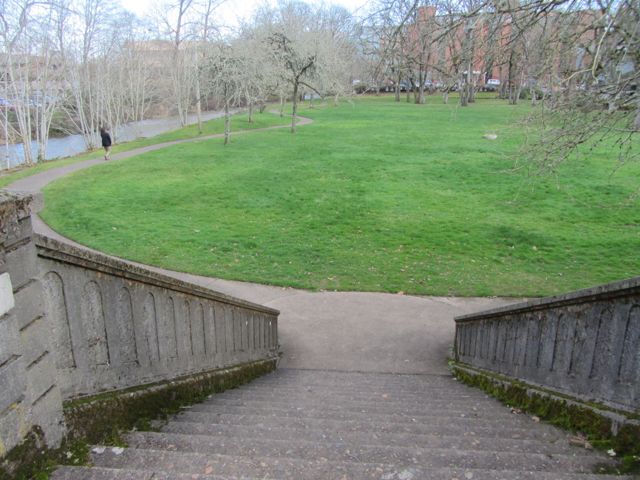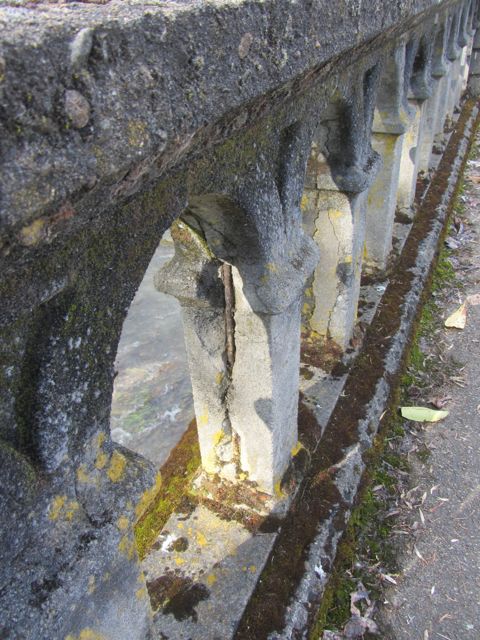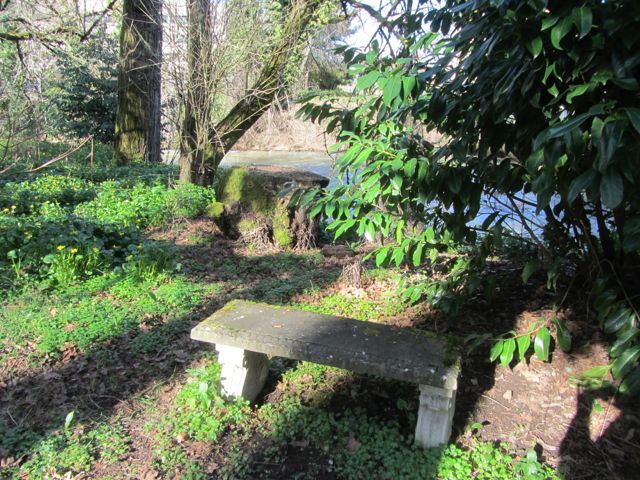Ellen Stevens and a group of citizens is working on saving the beautiful Church Street Bridge. It was built in 1928 and designed by then Salem bridge engineer R.A.Furrow, one-time colleague of well-known bridge designer Conde McCullough. The bridge is a beauty…
spanning Pringle Creek (which is a pretty swollen, roaring body of water today…due to our rain-that-will-not-stop)
Ellen walks a lot, and became disturbed by the deteriorated condition of the bridge. She was particularly interested in the restoration of design and the spirit of the old bridge. She came by the other day to show us some proposed designs for the balustrade replacements and she spoke so interestingly about the bridge we went to take a look during our brief sunny respite between storms…
The span is longer than we thought, and the bridge environs are gorgeous. The original bridge has a variety of curves and “balconies” that provide access and views…
and two exceptional curving staircases…one leading into Pringle Park…
the deterioration is accelerated due to the rusting re-bar inside the cement, causing the cement to break down…
and then…the moss…
The second stair leads down into the Woodland Chapel garden…where there are various serene delights…
The bridge advocacy group is meeting with the Salem Landmarks Commission March 20th and we’ll await word of support, or further advocacy needed ahead. There are 12 bridges from 1927-29 around Salem, all gems. Get out there and take a look!
















Reblogged this on David P. Craig and commented:
thanks Bonnie!
Our Center Street bridge was replaced with a very utilitarian model earlier this decade. It has not a modicum of charm.
Carol Sent from my iPhone
>
It looks like a gorgeous area!
Aren’t these wonderful? Aren’t we lucky to have these structures under our feet & in our sight? How I hope the commission is going to go forward with restoration! Meeting on the first day of Spring surely is a sign for renewal. Hooray for Ellen & co!
we know a few of these lovely bridges ourselves from our walks to and from town. it is delightful to see these pictures of the church street bridge and pringle park on this gloomy day. ellen is taking on a worthy and important crusade of preservation.
NOTE TO READERS: The Bridge that Ellen is going to Landmarks Commission about is the Winter Street Bridge…one block east of Church Street (near the hospital, for Salemites). That bridge is going to be demolished and replaced, probably with a single span, but with an effort to replace the cast concrete railings with period replacements (as has been done this winter on the Commercial Street bridge). The Church Street bridge in my blog post is considered “sound” so Ellen’s group is working for historic designation for this bridge for protection when replacement is imminent. If you are interested in the Church Street bridge and perhaps getting historic designation (it is with the boundaries of an historic district), you might want to consider joining the group.
Thank you, Bonnie Hull, for a lovely blog on the South Church Street Bridge, constructed in 1929, and credited to Ray Archie (R. A.) Furrow, C. E., Special Bridge Engineer, City of Salem from October 1, 1927 until August 31, 1930.
R. A. “Far” Furrow (1886-1972) and Master Bridge Builder Conde “Mac” B. McCullough (1887-1946) were colleagues, eleven months and thirteen days ago in age, attended the same engineering school at Iowa State College at Ames, and students of Anston Marston, C. E., (1864-1949) “one of the foremost American engineering educators of his time.” Two other students of Anston Marston are Elmina Wilson, C. E., M. S., America’s first woman Professor of Structural Engineering; and Archibald Alexander, C. E., M.E., African American civil engineer, who would build the Tidal Basin Bridge and Seawall, and Whitehurst Freeway in Washington, D. C.
R. A. Furrow also served as the Resident Engineer for the construction of Young’s Bay Bridge at Astoria (1921) the oldest existing coastal bridge designed by McCullough; the Willamette River Arch Bridge at Oregon City (1922) and McCullough’s masterpiece, Yaquina Bay Bridge at Newport (1934-36). The Resident Engineer is the individual who “made things happen — on schedule, on time, on budget” (Dr. Robert W. Hadlow).
R. A. Furrow also served as Special Reconstruction Engineer for the City of Astoria following the Great Fire of December 8, 1922 which destroyed the central city core, 32 city blocks, 220 businesses and houses. He re-built the public infrastructure of the City of Astoria with a system of innovative concrete chairwalls, sidewalks and concrete streets and underground tunnels for utilities, water and gas lines. The “design and vision was remarkable..” Astoria City Manager Paul Benoit 2012: in the 1920s, few municipalities in the Pacific Northwest had an underground public infrastructure system for utilities.
South Church Street Bridge is one of fifteen concrete bridges of note built during his tenure as Bridge Engineer. Located in the Gaiety Hill/Bush’s Pasture Park National Historic District, the structure has a number of signature details of the era: round arch panels railings, pedestrian stairway to a natural setting Pringle Creek Park; bush-hammered inset panels; arch curtain walls; a pedestrian balcony on the west side overlooking the confluence of Shelton Ditch and Pringle Creek, fluted piers, and 8 vintage Maberlite lamp posts.
In 1985, South Church Street Bridge was identified as one of only ten “outstanding historic bridges” of Slab, Beam and Girder type construction from over 6500 in the State of Oregon.
Thank you, for spotlighting Salem’s artistic qualities. And a special thanks to Ellen, Sofia, Susan, Karen.
word “ago” should read “apart”: Furrow and McCullough were eleven months and thirteen days apart in age
That bridge is a great beauty. I wonder how it can be saved/repaired. Anyone know? By the way, notice all the English Ivy growing in the trees: that’s not good. On another note, Bellevue Street apparently used to extend west from High Street south of the bridge. I was looking online for an historic photo of this and found your post.
Thank YOU Greenway Bridges Study Group for an informative description and article with the “real” facts…So much more meaningful to have the whole story. And good eye Ellen Stevens for getting the ball rolling to save this bridge!
We thank you, Ms. Hull: we will send an occasional note of update: again, we thank you